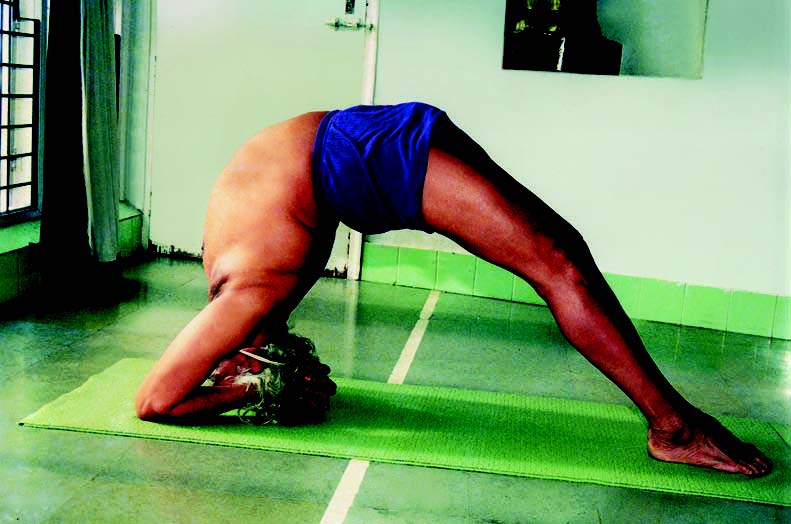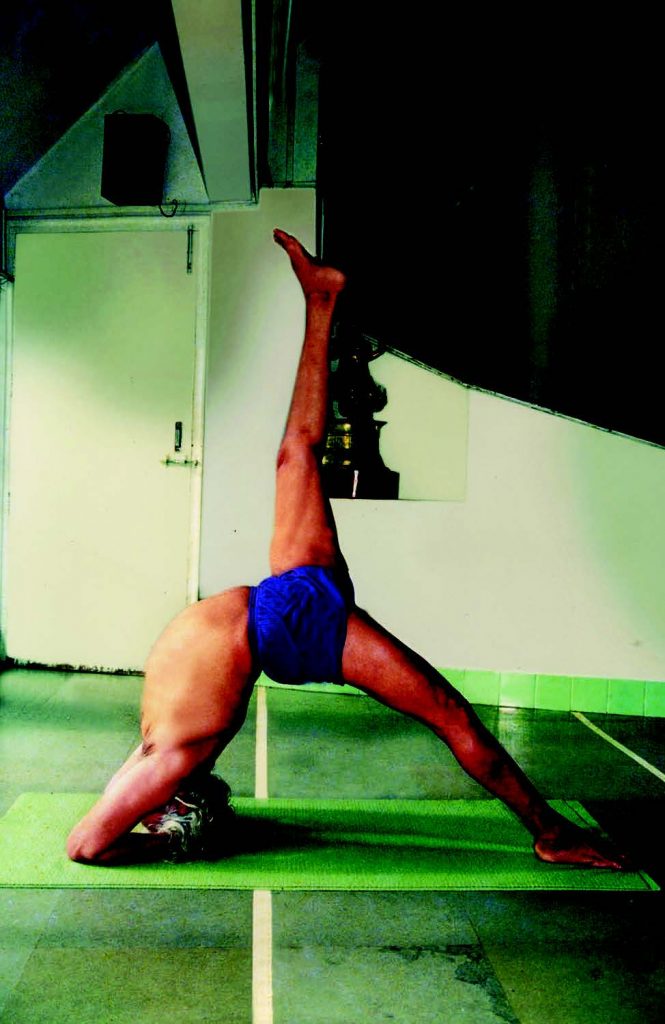
Born in India in 1918, B.K.S. Iyengar has been teaching yoga since the age of seventeen. An innovative and exacting teacher for more than sixty years, he has guided the establishment of many centers of Iyengar Yoga worldwide. His message is “Yoga is for everyone.”
At the age of ninety, Mr. Iyengar continues to practice every day at Ramamani Iyengar Memorial Institute in Pune (India), where he amazes everyone with headstands, backbends, standing poses at the tresde, and deep savasana. Occasionally he teaches his granddaughter or other close students, but for the most part he practices, daily for hours; that also is a lesson for students who witness him at work.
Every afternoon he is in the library studying, taking care of correspondence, working on his latest book, and greeting visitors with warmth and blessings. Alive, vibrant, and perceptive, he notices the smallest details of bodies—muscles, skin, quality of alignment. His presence is powerful and life-giving, soft and hard, rigorous and compassionate.
In February 2009, I went to Pune for a month of intensive study at the Institute, where B.K.S. Iyengar’s son, Prashant, his daughter, Geeta, and several of his students teach. As I entered the Institute, the very first person whom I saw was Mr. Iyengar. Without hesitation and full of gratitude, I bowed at his feet. Here was the man whose system of yoga had changed my life.
The interview was conducted at the end of that February session.
―Annie Schliffer
ANNIE SCHLIFFER: The theme of this issue of PARABOLA is “The Path.” How do you see the path of Yoga—your path?
B.K.S. IYENGAR: Actually, you have to go back to the traditions to understand. In the early days there were four paths, known as the path of Devotion, the path of Knowledge, the path of Action, and the path of Yoga. These are still the four paths for anyone to experience the one and only goal: that is, emancipation and freedom from the bondage of worldly life. There is the illusion that Bhakti, Jnana, and Karma is enough. But unless your arms and legs are clean, your brain is clear from all the doubts and confusions, and the heart is pure, one cannot reach emancipation. Therefore, the pillar of all these three parts is Yoga; what we call Patanjali Yoga.
AS: At ninety years old you are still practicing Yoga every day, doing back bends, hand stands, etc. I wonder if you can speak a little about your Yoga practice.
BKSI: When someone wears an orange robe, whether they are a practitioners or not, there’s a blind faith in people, thinking “he must be a spiritual man.” That has not been my path. I have lived like all ordinary human beings, and faced the upheavals of life. Looking at me, people may think because I wear no orange robe I am just a commercial, worldly person.
Secondly, there is the illusion that many of the yogis or sadhus have reached the level of “spiritual kingdom.” But it is only words—nobody knows their works, their actual works. They may say something, but are they doing what they are saying? I am a person who does what he says, even at my age. And I continue to practice because Yoga has helped me. Explicitly I teach the entire philosophy, but in the presentation of each asana and breath I do not speak publicly of what spiritual life is. Spiritual life begins only when you attempt to internalize completely. I am not an idol, but I practice what I speak. My life is open to each and every one to see. I am pure inside and pure outside. Whether I am nine or ninety does not matter to me. Life is flow from birth to death. And that flow should not be interrupted. And that’s why I practice.
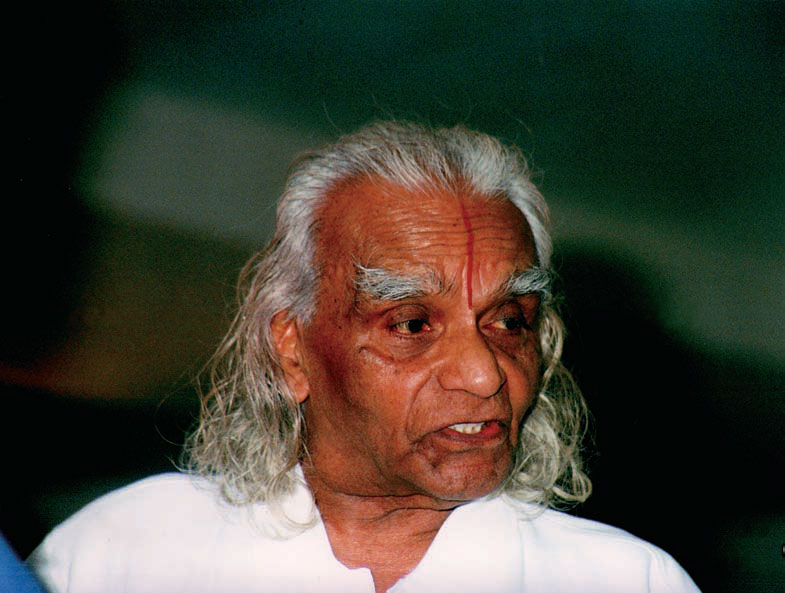
AS: The Yoga that you practice, and that you train others to practice, is very exact and very precise.
BKSI: Yes. You know, in my early days, when I was practicing the asanas, I was taught only on the physical level because I was not in good health. I understood that my guru thought that I might not go beyond gaining physical health. But as time passed I realized there was something more which was hidden, I questioned, “How can I bring that hidden quality of Yoga?” If one does meditation or whatever it may be, there needs to be some support. Without support nobody can meditate. I wanted to take the support of all the asanas that I learned and use them as a pillar for me to work on, day in and day out, to find out where it would lead me. And if you ask me today, nobody can define the practice of asana. They think it is all physical. However, not only is position of the physical body important, but also the precise placement of the organic body.
In the same way that roads and rails connect cities in a nation, the circulatory system and nervous system connect the parts of the body. These avenues, which are created by God, not by man, are created for nourishment to be carried from birth to death, so that nothing should decay. But because of our habits, things decay. Yoga came to restore the degenerated parts. When I started working, the hidden quality of yoga opened a way to practice and convey to my students how to observe, practice, and teach.
In Sutra 246 Patanjali says, “Asana is perfect firmness of body, steadiness of intelligence and benevolence of spirit.” But this has been misunderstood as “whatever position is comfortable you can stay in that pose.” These questions of “What is comfortable? Why struggle there? Where does it lead?” confine the practitioner to stay within the frame of the mind. You must cross beyond the mind to understand the spirit. This is the meaning of this aphorism.
Then, as for the effect of Asana he says, “Tatah dvandvah anabhighatah”—“The dualities disappear.” And the dualities according to academicians are heat and cold, honor and dishonor, etc. But Patanjali has said in Sutra 1.2, “Yojjah chittta vrtti nirodhah,” which we have to remember. “In order to restrain the movement of the consciousness, Yoga has come.” So that first sentence should be the first base, for anyone to proceed. But people forget. And that first word “Tatah” means “the Nature and the Soul.” The body belongs to the Nature which is eternal but destroyable. But Self is eternal, immovable, and it cannot be destroyed. So there is decay in the body, but there is no decay for the Self. The Self is like a mirror; when it is dusty you cannot see. So when the body decays, the dust, in the form of various ailments—physical, moral, mental, intellectual, etc.—engulfs the Soul and the self gets ill by these afflictions, sorrows, etc. Therefore Yoga asanas are taught so that the dualities between the intelligence of the body and the intelligence of the Soul are not varied but balanced evenly, so there is no duality between the body and the Self. That is the definition of the effect of the asana.
Another image I can give you is knitting a sweater. This body is “knitted” with fibers, sinews, ligaments, and so forth. It is said, “The camel can’t pass through the eye of a needle.” The needle is the consciousness, the eye of the needle is the intelligence, and the thread that you pass through the eye of the needle is the mind. If the mind, the thread, is rough can you push it through the needle? What do you do? You sharpen it. So you have to sharpen the mind, for the thread to pass through the eye of the needle. And the moment the tip of the thread passes through, do you think of the thread? You only knit with the needle because the thread is moving through the needle. So therefore I say, when the asanas are done, each and every fiber of the body is knitted through the asana.
The mind, the thread, has passed through the intelligence, the eye of the needle, for the needle to move in the body. So the needle and the fibers become one. And that is also another meaning of Oneness: “The dualities disappear,” which means “Oneness between the Body and the Soul comes.”
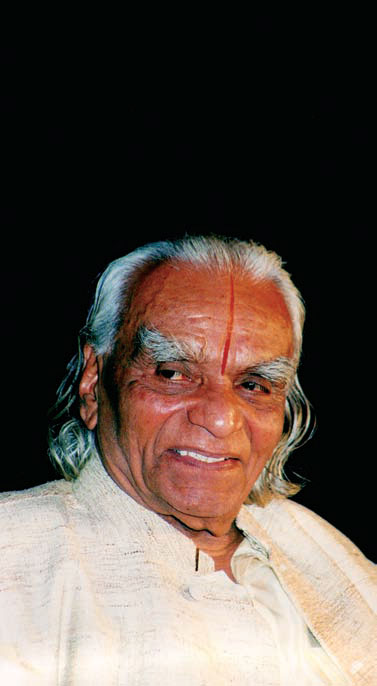 AS: Where do the eight limbs of Yoga come into this?
AS: Where do the eight limbs of Yoga come into this?
BKSI: The first two limbs of Patanjali are the ten ethical disciplines. These are the traditional foundation to build up character in a human being: yama: ahisma, satya, asteya, brahmacharya, aparigraha [non-violence, truthfulness, non-stealing, chastity, non-covetousness]; and niyama: soucha, santosa, tapas, svadhyaya, Isavara pranidhana [purity, contentment, religiosity, study of the sacred scriptures & oneself, surrender of the self to God]. This is why the very first words that Patanjali says in the first sutra are “Atha yoganusasanam” which means: what you say, you are to practice. The Yoga sutras begin with ethics, though Patanjali does not use the word ethics. The yamas and niyamas cannot be taught, cannot be shown, by experiments. They have to be taught by the stories of the eminent, spiritual people.
For example, we tell children, “If somebody comes, say Mommy is not at home.” Have we not taught children how to lie? And this is instinctive in each individual, to be aggressive, to be violent, to be untruthful, etc. They are the weaknesses of human beings. So Pantanjali, being a great grammarian and a noble person, describes the virtues of non-violence, truthfulness and so on. He says what to do, what not to do.
The next two limbs of Yoga are Asana and Pranayama. They require you to understand, recall, and study the Self, to know Who Am I? In order to know Who I am, to know yourself, you need to know your skin. You cannot forget this. You have to discover the inner layers what is hidden, by sensing the ski. Can I at least feel it?
The next limb, Dhyana or meditation, has no words, but only the experiencing state. First you must reach that stage. Not all people can get a Ph.D.; in a similar way, Dhyana cannot be done by all. There is much work to get a Ph.D.; and for Dhyana you have to work just as much. It is an experiencing subject not an expressive subject. Asana and Pranayama are not only expressive, but also experiencing subjects. Yama and Niyama are only expressive subjects and cannot be taught. That’s how Patanjali gave Yoga. And what I am teaching is a support pillar for people to go deep inside. To know the Self there is a Sadhana. But for the Self there is no Sadhana. Asanas can take you to the highest level of beatitude, emancipation, beatitude in life.
AS: It is clear you are at that place, but we are only aspiring.
BKSI: But do you believe it has been the work of one day? I have had to sweat, physically, mentally, intellectually to reach this. Even my brain was sweating! You are really much luckier than me. I had to struggle to find this. Here I am giving it to you, for you to start. I didn’t know which way to go. I was at a crossroads, wondering which way to follow. It was a big struggle for me and for you people just a little. And it is for you to keep that flame burning, to experience it. So as you are aspiring people, aspiration also comes from the self, does it not? The self is playing a dual role. You have to understand that dual role. The self is a seeker and it is a seer. Unfortunately, we are caught up in the plane of seeking but not seeing. So I request all of you, instead of seeking; whatever you do, see-—deep inside. See what happens in every part of the body.
Take a flower; so many petals are there. Each petal, Nature takes care of. So here you have to take care; nature will not take care. Similarly, we should be horticulturists inside [Laughs.] That is where, as horticulturists, Yoga helps us to work. And many people have forgotten that Patanjali in the fourth chapter of the third sutra explains that a yogi has to practice Sadhana like a farmer who builds his banks, collects water, works the land, then tills the land, removes the weed, scatters the seeds, gives the best fertilizer, in order to get the best harvest. So to get the best harvest is to become a seer, not a seeker. As long as you are a seeker, that means weeds are inside. So you are not “plowing” your body. Asanas and Pranavma are meant to plow the inner body so that you remove the intellectual, mental, moral weeds, you are completely clean inside/outside; and the state of “no seeker, only seer” comes by itself. Each asana acts as a plow to remove the intellectual weeds. Then in the third chapter, the last sutra, Patanjali says, “When the purity of the intelligence, cultivated intelligence, is equal to the intelligence of the Soul, you have reached emancipation,” In the last sutra, the third chapter, he says you have to plow so long that your natural instinct changes into intuitive knowledge. “Intuitive” is the knowledge of the Soul.
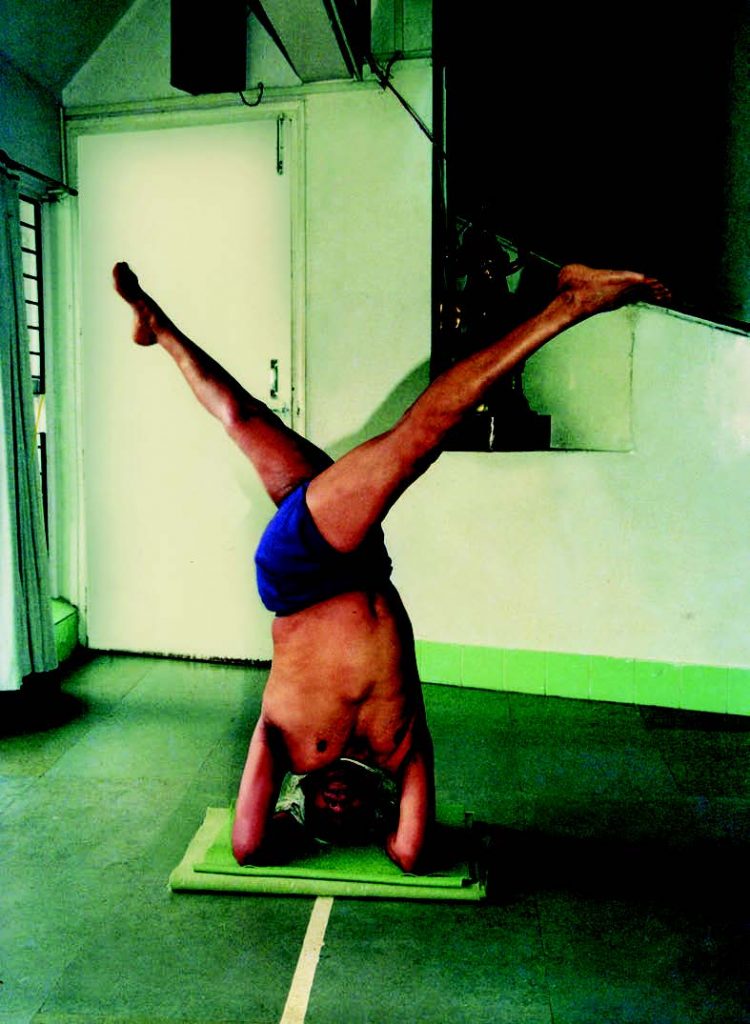
AS: It’s an amazing thing to be here for one month—only one month out of your ninety years [he laughs]–and yet to feel infinite possibility.
BKSI: That is why we use the words “Pmyatna saithilya ananta samapattibhyam”—“You have to live in an infinite state,” again from Patanjali. When you sit comfortably, whatever you do, you are limiting yourself. Where is the infinite? When are you touching the infinite? Instead you are in the finite. We practice in order to dissolve the finite, the physical body, the mental body, the intellectual body, the conscious body, and to allow the finite to merge into the Infinite Soul. That’s why I teach the Asana, to reach that level. The aim and the meaning is this merging. That’s all. You forget your body; you forget your mind, so that effortless effort sets in. You get the zeal to practice. There is no discipline; discipline comes by itself, in itself, does itself. The infinite guides the finite body to maintain that infinity in its finite field. That is the effect of Asana. You asked me why I am still practicing; this is why I am doing Asana to this day. It brought me light. Now I cannot remove that light. If I remove it, I am a dishonest practitioner or a preacher of Yoga. It has made me, and I will practice it. Though some people may call me only a physical practitioner, it does not matter to me. To the one that lighted my Soul, I cannot show disrespect. That is why I am practicing.
AS: Can anyone start Yoga?
BKSI: Why not? My friend, everybody is fit to start a right discipline. Yoga is one that guides a person in a true path.
AS: With the help of a teacher, anyone can discover that?
BKSI: All can discover it. It is meant for all. One may reach it soon; one may reach it a little later. But all are bound to reach that level one day or another.
AS: What a hopeful message.
BKSI: Thank you. God bless you. God bless you all. ♦
From Parabola Volume 34, No. 3 “The Path,” Fall 2009. This issue is available to purchase here. If you have enjoyed this piece, consider subscribing.
